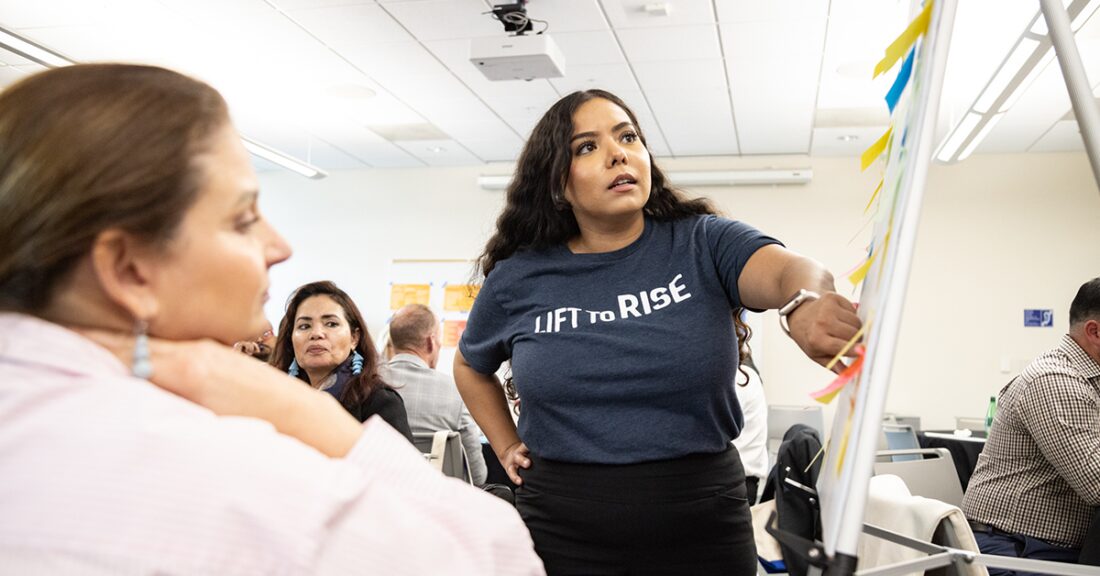A Bold 10-Year Goal for Affordable Housing in the Coachella Valley

Photo credit: Noé Montes for Lift to Rise
Lift to Rise and its partners are on track to add 10,000 new units of affordable housing to California’s Coachella Valley by 2028. Recognizing housing insecurity as a key factor in addressing poverty, local leaders used the Results Count® framework to prioritize this initiative.
“In 2015, it wasn’t broadly accepted that affordable housing is a root cause driver of all of these other oppressive things like food insecurity and homelessness,” said Heather Vaikona, president and chief executive officer of Lift to Rise. “Our initial Results Count work was to set a data baseline and see what was happening at the population level, not the individual program level.”
Learn more about Results Count
Results Count, the Annie E. Casey Foundation’s signature approach to leadership development, stresses the importance of collaboration, equity and the use of data to set targets and measure progress. Its tools and skills have helped Vaikona and her peers listen and respond to their community — and in the process, allow the voices of the people they serve to shape and refine how results are achieved.
Increasing Affordable Housing in Coachella Valley
Vaikona and her colleagues were part of a Results Count cohort that the Casey Foundation led with Feeding America, a national hunger-relief network. From 2015 to 2018, Vaikona laid the foundation for Lift to Rise. While she established it as a collective impact organization tackling food security, health, employment and housing, she developed proficiency in the Results Count approach.
The Coachella Valley, which comprises nine cities and several unincorporated communities, is a geographically vast and demographically diverse region in Southern California’s Riverside County. Known for its wealthy vacationers, music festival and recreation, the area’s hospitality economy is driven by a less visible year-round population of underpaid, primarily Latino workers.
“It was always evident that our economy is built on the backs of the labor of low-income people of color who are not paid enough money to stay housed or feed their children,” said Vaikona. “Before Results Count, we were constantly looking at smaller data baselines and missing the big thing.”
Instead of more narrow data points like rates of childhood obesity, food insecurity and access to credit, Lift to Rise found that the “big thing” was rent burden, a function of the supply and cost of housing. It began to focus on the number of people spending more than one-third of their income on rent.
“Usually, housing is discussed through a policy or investment lens, but our north star has always been that we want all Coachella Valley families to be healthy, stable and thriving,” said Vaikona. “To get there, we knew we needed to reduce rent burden and increase economic opportunity.”
It wouldn’t be enough to work incrementally. Instead, Lift to Rise set a bold 10-year goal to increase the housing supply by 10,000 units by 2028, thereby reducing regional rent burden by 30%.
“We [arrived at] that goal because between 2010 and 2018, the entire Valley produced an average of 38 units of affordable housing a year, and that wasn’t going to cut it at a population level,” said Vaikona. “Now, we have more than 1,600 units under construction in our region and are on target to hit our 10-year goal.”
The Housing Collaborative Action Network
According to Vaikona, being grounded in a shared result from the start has allowed the Lift to Rise to pursue transformational change. In 2017, the organization established the Housing Collaborative Action Network. It includes over 75 local stakeholders who have developed a shared vision to address the lack of affordable housing in the region. They include:
- resident groups;
- community-based organizations;
- private developers;
- nonprofit developers;
- local governments;
- political representatives; and
- funders.
Notably, the network has engaged linguistically isolated and underserved populations.
“The hardest thing to do is to work together with other folks, and then the second hardest thing to do is to face yourself,” said Vaikona. “Adaptive leadership includes learning how to name and acknowledge dynamics, explicitly racial dynamics, and learning how to lead in the context of the complex histories we’re all living in. Staying focused on that one piece that is our aligned contribution — that’s what has really set us up for success.”
Lift to Rise continues to build the Results Count competencies of staff through a grant from the Casey Foundation. All staff are encouraged to learn the framework’s core competencies and apply them by building and facilitating aligned meetings and work plans. Lift to Rise engages in a six-month planning period every other year to get the organization and its partners closer to their 10-year result.
“It’s a constant thing,” said Vaikona. “While we’re always trying to get it right, I know we couldn’t have built such a comprehensive collaboration without using the Results Count competencies.”





